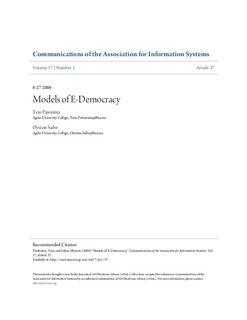| dc.contributor.author | Päivärinta, Tero | |
| dc.contributor.author | Sæbø, Øystein | |
| dc.date.accessioned | 2011-09-13T10:02:56Z | |
| dc.date.available | 2011-09-13T10:02:56Z | |
| dc.date.issued | 2006 | |
| dc.identifier.citation | Päivärinta, Tero and Sæbø, Øystein (2006) "Models of E-Democracy," Communications of the Association for Information Systems: Vol. 17, Article 37 | en_US |
| dc.identifier.issn | 1529-3181 | |
| dc.identifier.uri | http://hdl.handle.net/11250/136277 | |
| dc.description | Pulished article in Communications of the Association for Information Systems, 17 (1), 818-840. Also available from the publisher: http://aisel.aisnet.org/cais/vol17/iss1/37/ | en_US |
| dc.description.abstract | Several theories of E-Democracy have been presented, and implementations of and experiments in E-Democracy emerged. However, existing literature on the subject appears rather non-comprehensive, lacking an integrated basis, for gathering knowledge in the future. After an analysis of theories of E-Democracy versus implementations reported in related literature, we address the need for a model generally absent from contemporary theoretical literature: the Partisan model of E-Democracy. We aim to simplify the current "jungle" of E-Democracy models into four idealised models: the Liberal, the Deliberative, the Partisan, and the Direct. We aim to illustrate how current theories of E-Democracy, in addition to reported implementations, may be covered by these models. The explanatory potential of these four models is illustrated by analysing implementations of a communication technology for E-Democracy, the web-based discussion forum. We argue that, instead of viewing technology, such as the Internet, as a "black box," any implementation of E-Democracy should be adapted to the specific democracy model(s) pursued by a particular initiative. In addition, E-Democracy researchers could be more specific about their standard of democracy, in order to avoid artificial comparisons or criticisms of contemporary E-Democracy without an explicit framework of criteria. Finally, we discuss the possibilities of unifying the ideals from different models on E-Democracy. We suggest that any context of E-Democracy may in fact require elements from all four models to stay dynamic over time. | en_US |
| dc.language.iso | eng | en_US |
| dc.publisher | AIS Electronic Library | en_US |
| dc.subject | E-Democracy, democracy models, literature review | |
| dc.title | Models of E-Democracy | en_US |
| dc.type | Journal article | en_US |
| dc.type | Peer reviewed | en_US |
| dc.subject.nsi | VDP::Social science: 200::Library and information science: 320::Information and communication systems: 321 | en_US |
| dc.source.pagenumber | 818-840 | en_US |
| dc.source.volume | 17 | |
| dc.source.journal | Communications of the Association for Information Systems | |
| dc.source.issue | 1 | |
